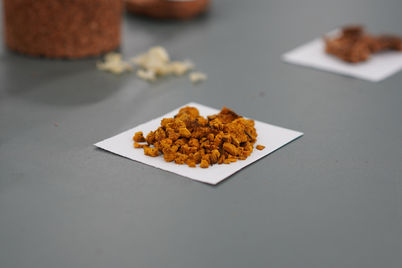

Cork is a fully recyclable and compostable material. With properties like excellent thermal and electrical insulation, durability, and cushioning capacity it has the potential to be reused in diverse ways.
We sourced our material in the form of wine corks from local restaurants. This was shredded into coarse and fine granules. Our goal was to combine this with a bio-based adhesive to create a sheet of material that would be flexible and cushioning without compromising on its tensile strength.
We found inspiration in origami folds and paper bag designs to create some visually appealing and functional modules.


With these experiments, we were able to get a better look at what cork was capable of. We found out that a lot of these natural adhesives, especially if not dried properly, get contaminated with mold. We added castor oil or vinegar to the recipes to reduce that. Despite that, the flour based recipes caught mold.
The milk based pucks had a surprising change in colour through the drying process. The glue worked very well with fine grain size and made the puck very tough. Although, some of the tests unexpectedly started expanding and cracking as soon as they were taken out of the mold.
The white fungus and tree sap worked really well to give us strong results. The gelatin, with added glycerin also proved to be a strong bond but with some additional flexibility to the piece.


We gradually narrowed down our experiments to see how far we could take cork’s compression and cushioning ability. Could it also be tensile? Would it be possible to wrap around things? How thin or thick can we make our pucks while still preserving these qualities?
Due to the granular nature of cork, achieving tensegrity as well as strength seemed impossible. We decided to experiment with adding different fibres to the cork to bind it better. Our initial experiments with dog fur and cotton cloth pieces were successful. We realized that using a fabric with a looser weave helped the glue seep through the layers better to give us stronger pieces.
With this approach, we decided that gelatin with glycerin was going to be the best adhesive to use.
Using 3D printed molds that indent the mountain and valley folds, we started experimenting with different origami patterns that could be pressed and transferred onto flat sheets of cork.
Simpler folds that all bent in a similar direction worked very well. After a few tests, we also figured out the best ratios of gelatin, glycerin and cork granules to use to avoid cracking the folds and stopping them from hardening over time.
We chose to showcase these properties in the form of a small "bag"- essentially, a cushioned and flexible covering to carry an object around.


























